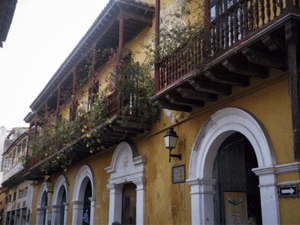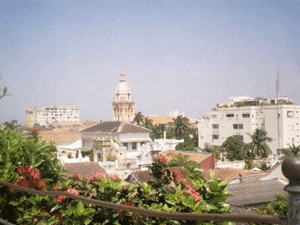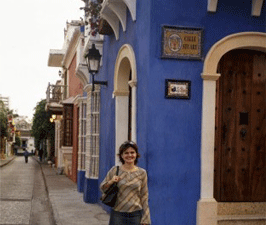Cartagena, Queen of the Caribbean
- Written by Demet Cabbar
- Published in Travel
Demet Cabbar – Washington, D.C.
We Turkish people tend to be harsh critics of ourselves when we are home. The moment we are away from our homeland, it all changes. We become the most patriotic and snobbish people of the world, yearning for “the air, water, sea, fish, music and most importantly the warmth of our people.”
We Turkish people tend to be harsh critics of ourselves when we are home. The moment we are away from our homeland, it all changes. We become the most patriotic and snobbish people of the world, yearning for “the air, water, sea, fish, music and most importantly the warmth of our people.”
It’s not easy to liken anything to the blue of the Aegean or the Mediterranean, or the green of the Black Sea. It’s not possible to compete with Istanbul’s charm, to challenge the grace of Ephesus, Cappadocia, Ishak Pasha Palace or the Nimrod Mountain.

It’s not easy to dare the lutes, the words or the breath of bards coming out of thousands of years of Anatolian culture. That’s why I have been comparing the places I visit with my homeland, and usually conclude that it’s no competition. I also compare the people of other lands to my own people, and conclude that they are boring and dull. But now I reached a country where I feel as if I am home, a country that left a trace in my heart, which made me want to share my experience and observations.
Honestly I did not think that I would love Colombia and its people this much before I made the trip. As a matter of fact, I was warned by many people who pointed out that “that place is full of guerillas and terrorists.” Unfortunately people of Colombia have been living the last 80 years with constant terror threat, just as we have. But also just like us, they did not turn their backs to life. They took up the challenge against the terror and embraced life as hard as they could, finding courage in music, dance, and literature. I understood once more after this trip that it is the people that shape a country. The reason why I felt at home in Colombia was the people- so warm, tolerant and ready to bend the rules to make the loved ones happy. People who learn to dance as they learn to crawl. Smiling people who love dressing up, singing, eating and their country.
MARQUEZ’S HOUSE
Cartagena, the city I stayed in, is known as the queen of Colombia and of the Caribbean. Colombia is the only country in South America with coastlines on the Pacific Ocean and the Caribbean Sea. It is also the homeland of the prominent writer Gabriel Garcia Marquez, who won the Nobel Prize for Literature in 1982 with One Hundred Years of Solitude. He is also the author of the great book Love in the Time if Cholera, which made him win a special place in many hearts. During my stay in Cartagena, I passed by Marquez’s house many times and thought that it is not a coincidence that the legendary writer came out of this land. Writers grow with the culture that they belong to; they find their resources in the soil they come from.
Cartagena is a very colorful city. Just like the streets, people are colorful, too. It is a mixture of Spanish-colonial, European, and Caribbean styles.

SHIPS FULL OF GOLD
In appreciation of its rich architecture and the ancient walls surrounding the city, UNESCO declared Cartagena a World Heritage Site in 1984. Why is this city surrounded by so many walls around and below it? Because it was the dream of every single pirate in the Caribbean between 16th and 19th centuries to conquer Cartagena, which was used by the Spanish to stockpile the gold collected from throughout South America. During this period, the Spanish Empire was financing its investments in Europe with gold that was mined in South America and carried to Spain by ship. Cartagena was the center where the gold was stored before being shipped to Spain.
In order to protect the city against attacks, Spanish ruler Philip II built the enormous walls around the city. The construction of the wall, which was named after him, took 20 years. Realizing that it is impossible to invade the city, the pirates of the Caribbean would wait off shore for the loaded ships to leave the port and try to ambush them there. Interestingly, after a while, official French and British fleets also took notice of the superiority of this method when attacking Cartagena and started to attack Spanish vessels as if they were pirates. Reportedly, many ships filled with gold sank with their cargo in the Caribbean Sea. As a result there are still rumors that massive treasures at the bottom of the sea wait to be taken out just outside Cartagena.
SIMON BOLIVAR THE HERO
Thanks to the famous General Simon Bolivar, Colombia gained its independence from Spain in 1821. The General is as important for Colombians as Ataturk is for Turks. Simon Bolivar officially initiated the struggle for independence by publishing the Cartagena Manifesto in 1812. That is why the city is especially important for Colombians.
Today there is no gold left in Cartagena and of course in South America. In fact, the South American gold can only be seen in European palaces and mansions or decorations owned by the nobility there. After the golden age was over, Cartagena lost its prominence for some time and the historic buildings were left to deteriorate. It was only 10 years ago that the government decided to restore many building and reopen them for use. Today Cartagena is shining with glory.

Youngsters getting together in the Santa Domingo Square sing from afternoon to late night. The streets are lively with vendors and dancers. The two oldest monasteries of the city are now Santa Clara and Santa Teresa Hotels, serving the guest with an old gist of authenticity.
SUMMER ALL THE TIME
There are direct flights to Cartagena on Wednesdays and Sundays from Miami. Ticket prices range between $400-700 and Colombia does not require a visa from Turkish citizens. The coastline of the country, especially Cartagena, is very safe. There are many diving opportunities in the islands off the city. In Colombia it is always summer. They actually have two seasons, rainy and dry. The seafood dishes are delicious. There is also coconut rice that I found as marvelous. The key difference between other Caribbean destinations and Cartagena is that the latter has culture, history and art in addition to mere natural beauty. It is also the land of warm and intimate people who stand up against life’s challenges. Just like we do.
IDENTITY CARD
Capital: Bogotá
Area: 1,038,700 km2
Neighbors: Brazil, Ecuador, Panama, Peru, and Venezuela
Population: 43.7 million
Language: Spanish
Age groups: 30% younger than 14, 63.7% between 15-64
GDP per Capita: $6,974
Inflation: 5.7%
Official Currency: Colombian Peso (1$=2,926 CP)
Main export items: Oil, coffee, coal, apparel, banana, flowers
Source: CIA World Factbook, July 1, 2002 and World Economic Outlook Database, April 2004
(June 2004, Issue 13th)

Cartegena streets.
It’s not easy to dare the lutes, the words or the breath of bards coming out of thousands of years of Anatolian culture. That’s why I have been comparing the places I visit with my homeland, and usually conclude that it’s no competition. I also compare the people of other lands to my own people, and conclude that they are boring and dull. But now I reached a country where I feel as if I am home, a country that left a trace in my heart, which made me want to share my experience and observations.
Honestly I did not think that I would love Colombia and its people this much before I made the trip. As a matter of fact, I was warned by many people who pointed out that “that place is full of guerillas and terrorists.” Unfortunately people of Colombia have been living the last 80 years with constant terror threat, just as we have. But also just like us, they did not turn their backs to life. They took up the challenge against the terror and embraced life as hard as they could, finding courage in music, dance, and literature. I understood once more after this trip that it is the people that shape a country. The reason why I felt at home in Colombia was the people- so warm, tolerant and ready to bend the rules to make the loved ones happy. People who learn to dance as they learn to crawl. Smiling people who love dressing up, singing, eating and their country.
MARQUEZ’S HOUSE
Cartagena, the city I stayed in, is known as the queen of Colombia and of the Caribbean. Colombia is the only country in South America with coastlines on the Pacific Ocean and the Caribbean Sea. It is also the homeland of the prominent writer Gabriel Garcia Marquez, who won the Nobel Prize for Literature in 1982 with One Hundred Years of Solitude. He is also the author of the great book Love in the Time if Cholera, which made him win a special place in many hearts. During my stay in Cartagena, I passed by Marquez’s house many times and thought that it is not a coincidence that the legendary writer came out of this land. Writers grow with the culture that they belong to; they find their resources in the soil they come from.
Cartagena is a very colorful city. Just like the streets, people are colorful, too. It is a mixture of Spanish-colonial, European, and Caribbean styles.

General view from Cartegena.
SHIPS FULL OF GOLD
In appreciation of its rich architecture and the ancient walls surrounding the city, UNESCO declared Cartagena a World Heritage Site in 1984. Why is this city surrounded by so many walls around and below it? Because it was the dream of every single pirate in the Caribbean between 16th and 19th centuries to conquer Cartagena, which was used by the Spanish to stockpile the gold collected from throughout South America. During this period, the Spanish Empire was financing its investments in Europe with gold that was mined in South America and carried to Spain by ship. Cartagena was the center where the gold was stored before being shipped to Spain.
In order to protect the city against attacks, Spanish ruler Philip II built the enormous walls around the city. The construction of the wall, which was named after him, took 20 years. Realizing that it is impossible to invade the city, the pirates of the Caribbean would wait off shore for the loaded ships to leave the port and try to ambush them there. Interestingly, after a while, official French and British fleets also took notice of the superiority of this method when attacking Cartagena and started to attack Spanish vessels as if they were pirates. Reportedly, many ships filled with gold sank with their cargo in the Caribbean Sea. As a result there are still rumors that massive treasures at the bottom of the sea wait to be taken out just outside Cartagena.
SIMON BOLIVAR THE HERO
Thanks to the famous General Simon Bolivar, Colombia gained its independence from Spain in 1821. The General is as important for Colombians as Ataturk is for Turks. Simon Bolivar officially initiated the struggle for independence by publishing the Cartagena Manifesto in 1812. That is why the city is especially important for Colombians.
Today there is no gold left in Cartagena and of course in South America. In fact, the South American gold can only be seen in European palaces and mansions or decorations owned by the nobility there. After the golden age was over, Cartagena lost its prominence for some time and the historic buildings were left to deteriorate. It was only 10 years ago that the government decided to restore many building and reopen them for use. Today Cartagena is shining with glory.

Marquez's house.
Youngsters getting together in the Santa Domingo Square sing from afternoon to late night. The streets are lively with vendors and dancers. The two oldest monasteries of the city are now Santa Clara and Santa Teresa Hotels, serving the guest with an old gist of authenticity.
SUMMER ALL THE TIME
There are direct flights to Cartagena on Wednesdays and Sundays from Miami. Ticket prices range between $400-700 and Colombia does not require a visa from Turkish citizens. The coastline of the country, especially Cartagena, is very safe. There are many diving opportunities in the islands off the city. In Colombia it is always summer. They actually have two seasons, rainy and dry. The seafood dishes are delicious. There is also coconut rice that I found as marvelous. The key difference between other Caribbean destinations and Cartagena is that the latter has culture, history and art in addition to mere natural beauty. It is also the land of warm and intimate people who stand up against life’s challenges. Just like we do.
IDENTITY CARD
Capital: Bogotá
Area: 1,038,700 km2
Neighbors: Brazil, Ecuador, Panama, Peru, and Venezuela
Population: 43.7 million
Language: Spanish
Age groups: 30% younger than 14, 63.7% between 15-64
GDP per Capita: $6,974
Inflation: 5.7%
Official Currency: Colombian Peso (1$=2,926 CP)
Main export items: Oil, coffee, coal, apparel, banana, flowers
Source: CIA World Factbook, July 1, 2002 and World Economic Outlook Database, April 2004
(June 2004, Issue 13th)
Last modified onSaturday, 06 May 2017 10:07
Tagged under









